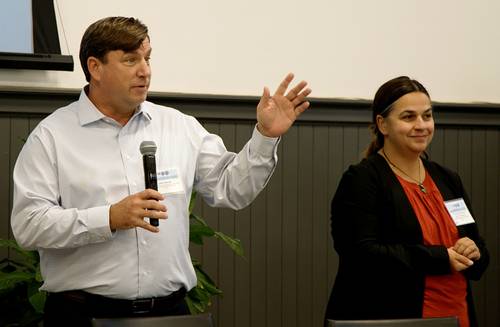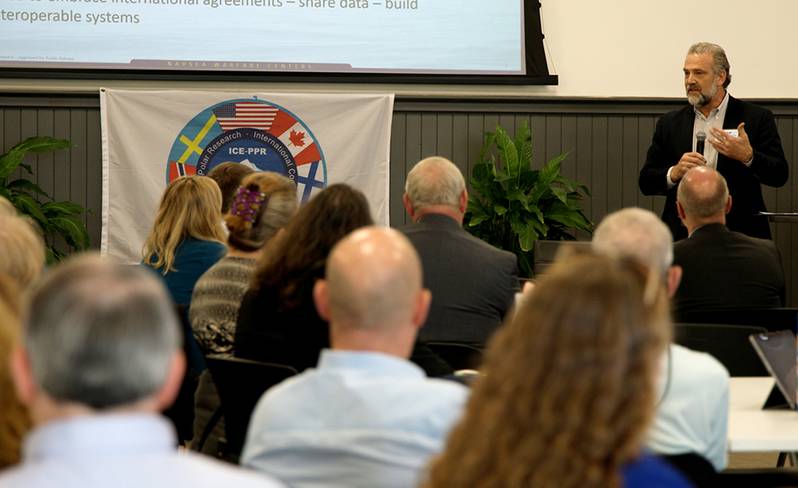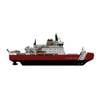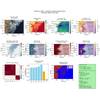Ocean Engineers and Scientists Share Ideas, Challenges at International Arctic Workshop

John Woods, director of International Engagement Office for the Office of Naval Research, and Dr. Lauren Freeman, senior oceanographer in the Naval Undersea Warfare Center Division Newport’s Ranges, Engineering and Analysis Department. (Photo: Leif Heimbold / U.S. Navy)
Collaborating to better understand how to operate in the Arctic environment was the goal of an international gathering addressing polar oceanography and operations held in Newport, Oct. 23-25.
The “Under the Ice Workshop,” and “2025 Ship to Shore High Latitude Experiment Planning Session,” engaged and united engineers, scientists, and operators from international defense and research organizations who are supporting the International Cooperative Engagement Program for Polar Research, also known as ICE-PPR.
ICE-PPR is a multilateral framework Memorandum of Understanding (MOU) that enables a 25-year engagement among the governments, academia, and industry of the U.S., Canada, Denmark, Finland, New Zealand, Norway and Sweden. The MOU can be used to address various areas of interest including polar environmental modeling, prediction, and information sharing; polar sensors and remote sensing techniques; polar communications and situational awareness; platform design and performance for polar environments; research, development, test and evaluation (RDT&E) infrastructure for polar environments, experimentation and demonstrations for polar environments; and operational research. RDT&E include the development of cold weather-capable designs, forecasting models, sensors, high-latitude communications, and navigation design.
More than 70 attendees from six nations and NATO participated in the workshop to network and share information as well as understand gaps in Arctic research. Participants worked to achieve several goals for the in-person workshop including:
- Understanding capabilities, needs and gaps across the ICE-PPR community,
- Identifying opportunities to collaborate, coordinate, and codify projects requiring formal project arrangements, and
- Designing the framework for a 2025 ship-to-shore, high-latitude experiment focused on polar oceanography operations under the ice.
The workshop began with briefings at NUWC Division Newport before all attendees convened at Innovate Newport, a local event and collaboration space.
Championing the workshop was John Woods, director of International Engagement Office for the Office of Naval Research, who was eager to bring together this international group of researchers and innovators.
“The goal of ICE-PPR is to increase international cooperation, to close gaps in capability. It’s a defense focus but it’s really an all of government effort from both the U.S. and our international partners,” Woods said. “So we want to leverage the expertise of those partners to increase capabilities across all the nations that are participating in ICE-PPR and that’s really why getting together is key. Because to share those ideas remotely just doesn’t work sometimes so you’ve got to bring everyone together in one place to really talk through those challenges.”
Dr. Lauren Freeman, senior oceanographer in Division Newport’s Ranges, Engineering and Analysis Department, hosted the workshop and will continue to lead efforts to coordinate and execute scientific experiment in the Arctic region.
“One of my first goals is simply to have them talking to each other and learning about what one another’s challenge are and what sort of resources we have but also where we can help each other out, which is one of the big motivators of having an international agreement such as ICE-PPR,” Freeman said. “We’re planning a sea test for 2025 which is going to be a technological demonstration of capabilities that our members already have and we’re going to be using that to do a formal gaps assessment to see where we can develop further technology, scientific algorithms and capability to aide everyone’s Arctic operations.”
Dr. Vic Ricci, chief technology officer at NUWC Headquarters, kicked off the presentations and discussed the role of the warfare centers in high latitude research.
“I think one of the ways the warfare centers contribute is through knowledge of our operational systems and actually our R&D systems,” Ricci said. “We bring a wealth of experience — surface, undersea, air — into understanding those systems and then understanding what we need to do to operate in extreme environments like the Arctic. So understanding what those environments are like and then translating that into what our systems need to look like — not just today but even into the future.”
Modeling and simulation efforts drive innovation for undersea warfare systems and Ricci envisions those efforts benefiting Arctic research as well.
“We can employ live, virtual, constructive systems to plan what we need to do in the Arctic without putting anything in the ice,” Ricci said. “Having digital representations of our environments, our systems, and potentially even threat systems are critically important so that we can understand not only how we will perform but also predict how they might perform and then adapt tactics or techniques around that. But more importantly one of the pieces that we can do is we can look at digital representations of our systems and the environment and we can test them in digital space before we ever get into water, before we ever get into the Arctic. We can test them and make refinements and that’s really predicated on how good our models are. We need as good a digital representation, digital engineering models of our systems but also relatively exquisite knowledge of the environment so they act realistically.”

Naval War College professor Kathleen Walsh led an expert panel discussion on Arctic Geopolitical Scene Setting. Naval War College experts discussed securing sea lines of communication, gas pipelines and fiber-optic cables in the North Sea, and the expansion of Russia and China’s Polar Silk Road in the Arctic region.
NUWC Division Newport ocean engineer Michelle Estaphan Owen of the Platforms and Payload Integration Department shared her expertise in unmanned undersea vehicles (UUVs) as part of the panel “Seabed to Space: A Look at Our Collective Assets and Capabilities.”
“UUVs in the Arctic provide a lower safety risk and more flexibility than manned solutions,” Estaphan Owen said, then added a caveat. “You may have to accept that you won’t have your asset back until summer, when the ice breaks up. If you are asking the vehicle to bottom and wait until it’s safe to recover, that is mid-June to mid-July, and that can be the new normal.”
NUWC Division Newport Chief Technology Officer Dr. Jason Gomez provided the ICE-PPR audience with a command overview before introducing two scientists giving presentation on their work. Dr. James Leblanc of Platforms and Payload Integration Department presented “Effect of Salt Water and Low Temperatures on the Mechanical Characteristics of Advanced Materials” and Jessica Desrochers of the Ranges, Engineering and Analysis Department presented “Beaufort Ducts and Acoustic Propagation, Sea Glider Work.”
Representatives from the Naval Surface Warfare Center (NSWC) Panama City Division also attended the workshop to offer their unique perspectives.
“I haven’t worked in the Arctic and ice before so I’ve been learning a lot about that and everyone is also learning about what the other people and organizations are doing and what assets they have. So we’re kind of setting the scene and learning the pieces of the puzzle we need to put together a joint experiment,” said Sonja Smith, operations research scientist and coordinator of the International S&T Program at the NSWC Panama City Division.
Because the Arctic is an international region, Trevor Kelly-Bissonnette, Naval Sea Systems Command’s director of International Programs, underscored the importance of establishing partnerships.
“Last week the U.S. issued their national strategic implementation plan for the Arctic region. It says the DoD [Department of Defense]needs to be working closer with its allies and partners and implementing strategies that will enable us to keep the Arctic open. In fact, they specifically mention the ICE-PPR, which is what this workshop is doing — pulling together our scientists and engineers and finding out how can we cooperate and do our research to characterize the environment,” Kelly-Bissonnette said.
Helping the diverse group of scientists and engineers achieve their goals was a team of meeting facilitators from Forge Forward, who will continue to develop future workshops for this effort. Upcoming events for the ICE-PPR community include a winter weather workshop to be held in Fairbanks, Alaska, and an unmanned aerial vehicle demonstration to be held in Thule, Greenland, in 2024.
“We live in a time when what happens in the Arctic doesn’t stay in the Arctic. Gaining a better understanding of this region and improving our ability to operate there will be vital for the welfare of the planet and for securing our children’s future,” said Dr. Daniel Sternlicht, distinguished scientist for littoral sensing technologies at NSWC Panama City Division.
The ICE-PPR 2025 Sea Test is a scouting opportunity for testing and demonstrating under ice, littoral, and ship to shore to land capabilities within the ICE-PPR network. The test will take place at a land-based station in Thule, Greenland. A 100-square-mile area around the land station will be utilized with on-ice terrestrial/cryo vehicles, autonomous underwater vehicles, moored sensors and ships.
Participants will bring platforms, sensors, technology, or capability of interest to test over a two- to three-week period. The broader goal is understanding what environmental measurements the team can measure well currently and what gaps they may have in measurements or algorithms. The gaps assessment will drive future ICE-PPR project agreements and collaborations to build new platforms or sensors.
















 December 2025
December 2025



